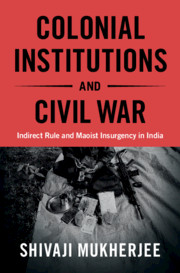Book contents
- Colonial Institutions and Civil War
- Cambridge Studies in Contentious Politics
- Colonial Institutions and Civil War
- Copyright page
- Contents
- Figures
- Tables
- Acknowledgments
- Part I Theory
- Part II Qualitative and Quantitative Testing
- 4 Qualitative Analysis of Maoist Strategy and Rebel Agency
- 5 Quantitative Testing of Effects of British Indirect Rule on Maoist Insurgency
- 6 Colonial Choice or Random Contingency? Addressing Selection Bias in British Indirect Rule
- 7 Maoist Insurgency in Chhattisgarh: The Raja of Bastar and Tribal Rebellion
- 8 Maoist Insurgency in Andhra Pradesh: The Nizam’s Shadow on Telangana
- Part III Generalizability
- Bibliography
- Index
- Series page
4 - Qualitative Analysis of Maoist Strategy and Rebel Agency
from Part II - Qualitative and Quantitative Testing
Published online by Cambridge University Press: 15 May 2021
- Colonial Institutions and Civil War
- Cambridge Studies in Contentious Politics
- Colonial Institutions and Civil War
- Copyright page
- Contents
- Figures
- Tables
- Acknowledgments
- Part I Theory
- Part II Qualitative and Quantitative Testing
- 4 Qualitative Analysis of Maoist Strategy and Rebel Agency
- 5 Quantitative Testing of Effects of British Indirect Rule on Maoist Insurgency
- 6 Colonial Choice or Random Contingency? Addressing Selection Bias in British Indirect Rule
- 7 Maoist Insurgency in Chhattisgarh: The Raja of Bastar and Tribal Rebellion
- 8 Maoist Insurgency in Andhra Pradesh: The Nizam’s Shadow on Telangana
- Part III Generalizability
- Bibliography
- Index
- Series page
Summary
While chapter 3 outlines how colonial indirect rule created the structural conditions for Maoist insurgency through multiple causal pathways, it also emphasizes that rebel agency in the form of ideological frames and organizational legacies plays an equally important role in mobilizing the ethnic networks of lower castes and tribes. In this chapter, I provide qualitative evidence to demonstrate this interaction between rebel agency and structural conditions created by colonial institutions. I first provide a detailed history of the organizational evolution of the various Maoist factions since the 1960s. Then, I use fieldwork interviews and textual analysis of Maoist documents to demonstrate that the Maoists are strategic about their choice of area, based on local politics, terrain, ethnic composition, and level of economic development. However, even within those areas they considered favorable based on terrain, inequality, and politics, they were successful only where the British colonial institutions of zamindari (landlord) land tenure or certain types of princely states were present. This demonstrates that rebel agency interacts with and is constrained by the opportunity structures of land/ethnic inequality available in areas of former indirect rule and revenue collection.
Keywords
- Type
- Chapter
- Information
- Colonial Institutions and Civil WarIndirect Rule and Maoist Insurgency in India, pp. 87 - 112Publisher: Cambridge University PressPrint publication year: 2021



